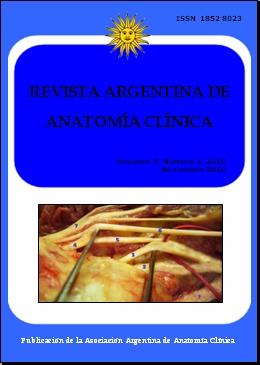ANATOMICAL KNOWLEDGE AND DIAGNOSTIC IMAGES IN MEDICAL EDUCATION. EL CONOCIMIENTO ANATÓMICO Y LAS IMÁGENES DIAGNÓSTICAS EN LA ENSEÑANZA DE LA MEDICINA
DOI:
https://doi.org/10.31051/1852.8023.v2.n3.13892Palabras clave:
anatomy learning, diagnostic images learning, medicine curriculum, aprendizaje de Anatomía, aprendizaje de imágenes diagnósticas, curriculum de MedicinaResumen
La importancia del conocimiento anatómico para la interpretación de las imágenes diagnósticas es reconocida y aceptada. El desarrollo tecnológico basado en tomografía axial computada y resonancia magnética nuclear han incrementado los requerimientos. En nuestra Facultad, el curso de Anatomía incluye la identificación de estructuras anatómicas normales. Intentamos demostrar los resultados a largo plazo de este cambio curricular. Este estudio consideró dos grupos: A) 274 estudiantes de primer año, B) 100 médicos recientemente graduados. Ambos grupos fueron evaluados con un cuestionario sobre las mismas tomografía axial computada y resonancia magnética nuclear. En el grupo A, el 13% de los estudiantes respondió correctamente, mientras que nadie lo hizo así en el grupo B. Dos por ciento del grupo A dieron respuestas erróneas a todas las preguntas, mientras que ascendió al 26% en el grupo B. El promedio de respuestas correctas fue de 60% en el grupo A y de 45% en el B. El grupo B se subdividió en B1) aquellos graduados que estudiaron anatomía con imágenes diagnósticas y B2) quienes no lo hicieron. Las respuestas correctas del grupo B1 fue 66% y del grupo B2, 40%. Estos resultados muestran la significación del conocimiento anatómico para la identificación de las diferentes estructuras en imágenes diagnósticas. Mientras los estudiantes desarrollaban el curso de Anatomía la identificación fue más sencilla, y resultó más compleja cuando transcurrió el tiempo. Sin embargo, los resultados fueron mejores en aquellos graduados que cursaron con identificación de estructuras anatómicas en imágenes diagnósticas que en aquellos que no lo hicieron.
The importance of anatomical knowledge for the comprehensive understanding of the diagnostic images is well known and accepted. Development of new techniques, based on computerized tomography and magnetic resonance have increased the requisite core knowledge. In our Faculty, the course of Anatomy includes the identification of normal anatomical structures in diagnostic images. We intend to demonstrate the long-term results provided by this curricular change. This study considered the following two groups: A) 274 first year medical students, B) 100 recently graduated physicians. Both groups were evaluated on their comprehension of computed tomography and magnetic resonance. In group A, 13% of the students answered all questions correctly; while 0% did in group B. Two per cent of the people in group A incorrectly answered all the questions; this percentage rose to 26% in group B. The average of correct answers in group A was 60%, while it was 45% in group B. Group B was further subdivided into B1) those graduates that studied anatomy with diagnostic images and B2) those who did not. Group B1 answered correctly on 66% of questions and group B2’s correct responses were at 40%.These results showed the significance of anatomical knowledge necessary to identify the different structures in diagnostic images. Students scored better on this evaluation instrument when they were taking Anatomy, as compared to graduates who were further removed from the content. However, results were better for those graduates that had taken an anatomy course identifying the anatomical structures in the diagnostic images, than those who did not.
Referencias
De Barros N, Junqueira Rodrígues C, Junqueira Rodrígues A Jr, De Negri Germano M A, Cerri G G. 2001. The value of teaching sectional anatomy to improve CT scan interpretation. Clin Anat 14: 36-41.
Erkonen W E, Albanese M A, Smith W L, Pantazis N J. 1992. Effectiveness of teaching radiologic image interpretation in gross anatomy. A long-term follow-up. Invest Radiol 27: 264-66.
Erkonen W E, Vydareny K H, Sandra A, Ferguson K A, Kreiter C D. 2000. Interinstitutional study to compare the effectiveness of a radiology-anatomy module of instruction. Academic radiology 7: 700-04.
Gunderman RB, Wilson PK. 2005. Viewpoint: exploring the human interior: the roles of cadaver dissection and radiologic imaging in teaching anatomy. Acad Med 80: 745-49.
Miles AK. 2005. Diagnostic imaging in undergraduate medical education: an expanding role. Clin Radiol 60: 742-45.
Mitchell BS, Williams JE. 2002. Trends in radiological anatomy teaching in the U. K. and Ireland. Clin Radiol 57: 1070-72.
Teichgräber UK, Meyer JM, Poulsen Nautrup C, von Rautenfeld DB. 1996. Ultrasound anatomy: a practical teaching system in human gross anatomy. Med Educ 30: 296-98.
Descargas
Publicado
Número
Sección
Licencia
Los autores/as conservarán sus derechos de autor y garantizarán a la revista el derecho de primera publicación de su obra, el cuál estará simultáneamente sujeto a la Licencia de reconocimiento de Creative Commons que permite a terceros compartir la obra siempre que se indique su autor y su primera publicación en esta revista. Su utilización estará restringida a fines no comerciales.
Una vez aceptado el manuscrito para publicación, los autores deberán firmar la cesión de los derechos de impresión a la Asociación Argentina de Anatomía Clínica, a fin de poder editar, publicar y dar la mayor difusión al texto de la contribución.



